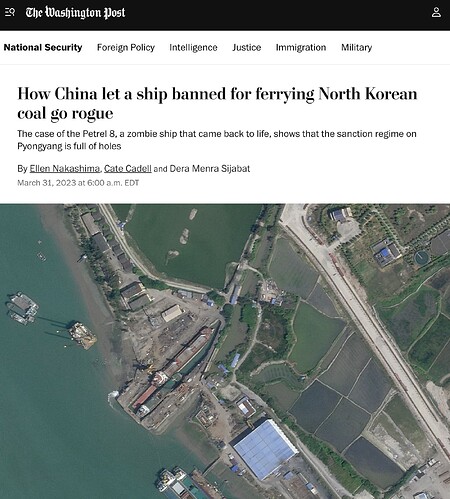-
联合国在2017年对一艘将朝鲜煤炭运往中国的中国籍船只 "海燕8号 "实施了港口禁令。这本应是一个死刑判决,注定这艘船将被废弃,或被置于 "飞翔的荷兰人 "的困境中。尽管如此,"海燕8号 "在中国法院的帮助下获得了缓刑,被修复并在违反制裁的情况下回到了开放水域。
-
联合国文件显示,中国对朝鲜的非法活动越来越视而不见,而 "海燕8号 "是一个罕见的、详细的例子,说明这种情况究竟是如何发生的。官方法庭文件和独立研究人员提供的信息显示,中国当局不仅知道 "海燕8号 "受到制裁,而且允许它被拍卖并非法停靠在多个港口–有时还使用欺诈性身份。
-
中国和俄罗斯一直无视制裁,这使得朝鲜能够发射创纪录数量的导弹,包括向日本海发射数枚导弹。一个联合国专家小组目前正在调查此案,他们的调查结果将于4月公布。
-
Petrel 8号货轮在2017年被卖给了一家香港公司,并开始向朝鲜非法运煤。联合国会员国向专家小组透露,该船被发现在朝鲜泰安装载煤炭。卫星图像证实货物是煤。
-
该船在进入朝鲜水域后会 “变黑”,关闭其自动识别系统以隐藏其位置。在一次航行中,它报告说吃水增加,表明它已经装上了货物。在返回中国并卸下货物之前,它在俄罗斯进行了一次 “伪装港口访问”。
-
联合国安理会于2017年10月一致投票制裁海燕8号,禁止它进入任何港口。这艘船被打上了国旗,这意味着它没有护照,任何国家都不能在不违反制裁制度的情况下给这艘船换旗。
-
海燕8号在实施入港禁令后不久驶出中国东北,最终在营口港附近的开放水域定居。
-
船员们在船上滞留了三个月,由于缺乏燃料和食物而发出了求救信号。
-
中国当局派出一艘破冰船将该船拖回营口港,该船被法院拘留两年。
-
海燕8号在中国法院的一个拍卖网站上挂牌拍卖,以95万美元的价格卖给了一个叫葛宝宏的人。
-
该船离开营口,在曹妃甸港停泊,违反了联合国的禁令。
-
然后,它沿着海岸线航行了1000英里,来到中国福建省东南部的福安马头船厂,这也违反了禁令。
-
2022年5月,海燕8号被卖给了一家名为P.T. Lintas Bahari Nusantara的印尼货运公司,价格为380万美元。
-
买家不知道这艘船的受制裁状态,它被换成了纽埃的船旗,这也是违反制裁的行为。
-
根据AIS的信号,该船随后又被重新投入使用。
-
2022年6月,"海燕8号 "以假船名驶过中国南海,交替使用原产国旗和识别号码转换。到7月3日,它停靠在爪哇岛西部的一个船厂,并接受了港口当局的检查。它已经改了名字,并在蒙古国旗下注册。美国驻雅加达大使馆发现它被列入联合国制裁名单,于是将其扣押。印度尼西亚政府要求将其从名单上删除,但尚未采取任何行动。
-
海燕8号是60艘因违反朝鲜制裁制度而被指认的船只之一,该制度禁止向另一艘船运输或转让煤炭、石油或武器。中国和俄罗斯已经不再同意新的指定,而是努力解除制裁制度。这两个国家否决了一项在2021年实施额外制裁的决议。中国公司一直在中国水域从事非法的船对船转让受制裁的朝鲜商品。
-
拜登政府愿意与朝鲜进行会谈,但金正恩没有表现出任何意愿。美国和中国之间的关系仍然很冷淡,而中国越来越多地将朝鲜视为盟友。制裁只有在执行的情况下才能发挥作用,但中国和俄罗斯对执行的阻挠使我们很难知道其影响。
-
The United Nations placed a port ban on a Chinese-owned ship, the Petrel 8, that had been ferrying North Korean coal to China in 2017. This should have been a death sentence, dooming the vessel to the scrapheap or to the limbo of a “flying Dutchman.” Despite this, the Petrel 8 was given a reprieve with the help of Chinese courts, repaired and returned to open waters in breach of sanctions.
-
United Nations documents show that China has increasingly turned a blind eye to illicit North Korean activity, and the Petrel 8 is a rare, detailed example of exactly how that happens. Official court documents and information from independent researchers show that Chinese authorities not only knew the Petrel 8 was under sanction, but allowed it to be auctioned off and dock illicitly in multiple ports — at times using fraudulent identities.
-
China and Russia have been ignoring the sanctions, which has allowed North Korea to launch a record number of missiles, including several into the Sea of Japan. A United Nations Panel of Experts is currently probing the case, and their findings are due out in April.
-
The Petrel 8 cargo vessel was sold to a Hong Kong-based firm in 2017, and it began making illicit coal runs to North Korea. The U.N. member state tipped the Panel of Experts that the vessel had been spotted loading coal at Taean, North Korea. Satellite imagery confirmed the cargo to be coal.
-
The ship would go “dark” when entering North Korean waters, turning off its automated identification system to hide its location. On one voyage, it reported an increase in its draft, indicating it had taken on a cargo. It made a “decoy port visit” in Russia before returning to China and discharging its cargo.
-
The United Nations Security Council voted unanimously to sanction the Petrel 8 in October 2017, barring it from entering any port. The ship was deflagged, meaning it was without a passport, and no state may reflag the ship without violating the sanctions regime.
-
The Petrel 8 sailed out of northeastern China shortly after a port entry ban was imposed, eventually settling in open waters near Yingkou Port.
-
The crew was stranded on the ship for three months and sent up a distress signal due to lack of fuel and food.
-
Chinese authorities sent out an icebreaker to tow the ship back to Yingkou port and it was placed under court custody for two years.
-
The Petrel 8 was listed for auction on a Chinese court auction website and sold for $950,000 to an individual named Ge Baohong.
-
The ship left Yingkou and put in at Caofeidian port in violation of the U.N. ban.
-
It then sailed 1,000 miles down the coastline to Fuan Matou shipyard in China’s southeastern Fujian Province, also a violation of the ban.
-
In May 2022, the Petrel 8 was sold to an Indonesian freight shipping firm named P.T. Lintas Bahari Nusantara for $3.8 million.
-
The buyer was unaware of the ship’s sanctioned status and it was reflagged with Niue, another violation of sanctions.
-
The ship was then put back on the move, according to AIS signals.
-
In June 2022, the Petrel 8 sailed through the South China Sea under a false ship name, with an alternating flag of origin and an identification number switch. By July 3, it docked in a shipyard in western Java and was inspected by the port authority. It had changed its name and was registered under the flag of Mongolia. The U.S. Embassy in Jakarta found it was on the U.N. sanctions list and it was impounded. The Indonesian government asked for it to be removed from the list, but no action has been taken yet.
-
The Petrel 8 is one of 60 vessels designated for violating the North Korean sanctions regime that prevents the transport or transfer to another ship of coal, petroleum, or weapons. China and Russia have stopped agreeing to new designations and have instead worked to lift the sanctions regime. The two countries vetoed a resolution to impose additional sanctions in 2021. Chinese companies have been engaging in illicit ship-to-ship transfers of sanctioned North Korean commodities in Chinese waters.
-
The Biden administration is willing to engage in talks with North Korea, but Kim Jong Un has shown no inclination. Relations between the US and China remain frosty, and China increasingly sees North Korea as an ally. Sanctions can only work if implemented, but China and Russia’s obstruction of enforcement has made it difficult to know their impact.
https://www.washingtonpost.com/national-security/2023/03/31/china-north-korea-sanctions-ship/
